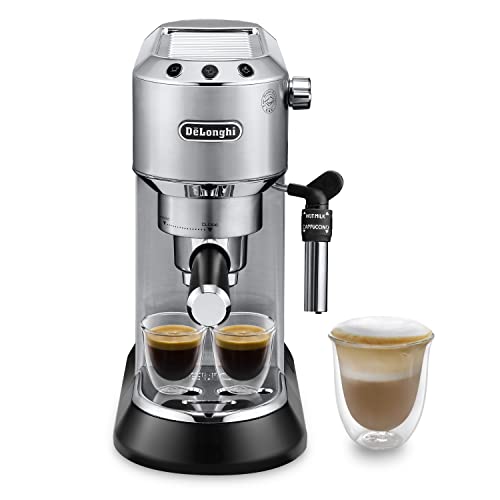How to Maintain Espresso best cheap espresso machine can be a great addition to businesses such as hair salons and doctors' offices, and car dealerships. These delicious drinks can improve the patience of your customers when they are waiting for service, and improve the atmosphere in your establishment.
This innovative machine is an award-winning Good Housekeeping 2022 Espresso winner makes use of smart dosing to measure and distribute the perfect amount of coffee ground for each shot. It also has a milk froth which performed well in our tests.
The Basics
Espresso machines are a fantastic addition for any home or office. They are able to make various drinks, including cappuccinos and lattes. They function by pushing hot water through ground coffee under pressure. This creates a concentrated shot that is full of flavor. It's a great source of caffeine, which can be an effective stimulant.
These machines are available in a broad range of sizes, from small ones for home use to larger ones to serve commercial needs. They are available in semi-automatic as well as manual designs. Manual machines require the user to regulate the flow of water and pressure, and semi-automatic models include an inbuilt pump that handles this for you. Some semi-automatic models have grinders, while others do not. The type of machine you decide to purchase will be based on your personal preferences and budget.
The manual espresso machine is operated by turning a handle which pushes water through the grounds of a filter basket. This type of machine is usually referred to as a macchinetta or caffettiera, and it is the most common form of espresso maker. It features the bottom chamber, which holds the water, and top chamber with the filter made of metal. When it is heated, the steam from the water is pushed through the grounds, and finally into the top chamber, where the brewed espresso is ready to serve.
Variety
Based on your requirements the options are endless. You can choose from a range of espresso machines. There are manual, semi-automatic and fully automated espresso machines. Each has a unique method of making an espresso shot and a range of other drinks like cappuccinos and lattes.
The first machines weren't fully automated. They required the user to use the lever to create the pressure necessary to pull a shot. These machines are still available but they aren't as widespread due to the work required and the strain they could cause. Modern espresso machines generate pressure using a variety mechanisms such as screw, push and see-saw designs. This allows users to control pre-infusion, water volume and pressure more precisely than with the lever machine.

A pump-driven espresso machine is akin to the stovetop moka pot, however, it uses an electric pump instead of steam to press the grounds. The boiler heats water until boiling point, and the pump then pushes the water through a group head. They are the most sought-after kind of espresso machines and are generally cheaper than other types.
Semi-automatic espresso machines incorporate the best characteristics of manual and pump-driven espresso machines. They allow you to grind the beans and tamp them, however motors control the pressure to ensure consistency. They also have a separate chamber that warms and froths milk and some come with a built-in grinder.
Functions
Commercial espresso machines can produce a wide range of coffees, including espressos at the press of a button. They use pre-packaged espresso capsules that are precisely dosed and packed to make a single cup of espresso or coffee. These machines are popular in offices with lots of traffic because they do away with the necessity for a grinding device or dosing machine, as well as tamping. Since they do not have steam capabilities and a separate milk frother is required to make cappuccinos as well as lattes.
Many cafes in Europe employed steam machines to increase production and decrease brewing time. However, the early machines were heated over an open flame, resulting in inconsistent temperature and pressure. Inventor Angelo Moriondo of Turin, Italy is credited with creating the first machine that was capable of making espresso without steam.
The most popular type of machine today is the pump-driven espresso machine. These machines come with a portafilter in which ground espresso beans are packed. When the valve is adjusted to the espresso position the water is pumped at 15 atmospheres pressure from the heating vessel. After the brew cycle is completed, the portafilter is removed and emptied to be cleaned.
Automatic espresso machines automate semi-automatic systems by controlling the extraction time based on internal or volumetric timers. They also limit the barista's ability to tamp or grind coffee, which may affect the quality of the final product.
Maintenance
Espresso machines are not the most elegant part of a coffee shop, but they're extremely important. How you maintain your espresso machine will affect the quality and taste of your drinks.
A clean espresso machine will ensure the flavor of your coffee doesn't suffer and your customer's experience is enjoyable. Regularly scheduled cleanings will prolong the life of your espresso machine.
Use a damp, clean cloth to clean the baskets and portafilters every time you shift to remove any residue or oils. In this process, backflush the portafilter gasket (the seal between the portafilter's head and the group head) by inserting a nylon brush inside the gasket, and moving it around to remove any accumulation. Rinse the gasket in water and run it through until the water is clear.
Mix espresso machine cleaner with water in a container, following the directions of the manufacturer once a week, or as required. Then soak the portafilters, gratings, and baskets overnight in the cleaning solution. If your espresso maker comes with a steam wand or screen, remove them from the set using an screwdriver. Make sure to separate them from the cleaning solution.
